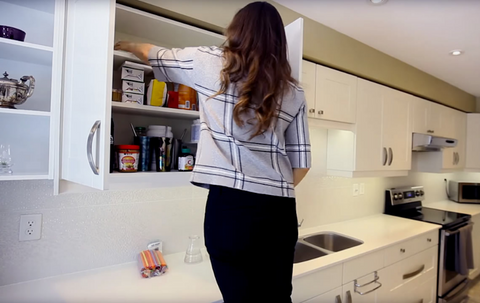As we slowly transition from spring to summer, it’s a good time to get started on all that spring cleaning – and why not start with the kitchen?
While most spring cleaning checklists will have you focused on the garage or basement, decluttering a messy pantry can pay off big-time since it's a daily hotspot in every home.
Ready to get started?
Below we highlight 5 great tips to kickstart your pantry organization and cleaning in 2021:
#1: Empty Fridge & Cabinets
The first step is to pull everything out of your fridge, freezer, cabinets, and pantry, and take inventory of what you have and what you need.
Chances are you’re going to find a lot of items that are past their “best before” date, so make sure to keep a garbage bag, recycling bin, and composter nearby for anything that’s getting tossed.
Try to be as ruthless as possible here. Kitchen storage space can be a real pain at times, so discard or donate whatever you don’t need.

You may also want to take inventory of your appliances, cooking tools, and equipment – it could be a great opportunity to replace an old cutting board!
And while you’re at it, consider vacuuming and wiping down all of the surfaces in your pantry to keep any crumbs or spills in check.
#2: Reorganize
Once everything’s emptied out, it’s time to think about how you want to reorganize your kitchen.
It might sound like a no-brainer, but grouping similar items together – like spices, snacks, cooking oils, and more – is one of the most effective ways to keep a streamlined and organized kitchen.
This also applies to nonfood stuff, like dishes, glassware, appliances, and more.

Of course, every kitchen has different storage availability. If you’re low on space, another great option is to divide your kitchen into “zones.”
For example, one zone could be dinner items and include everything from pasta to dinner condiments, and more, while others zones could be breakfast foods, baking supplies, and more.
Another common strategy is to follow a “first in, first out” system for food storage. Essentially, what this means is storing food in such a way that newly bought items (like beverages, pasta, and broths) get put at the back of the pantry while older items are at the front.

You’ll also most likely end up with a “general” zone with food staples that have long shelf lives. But even here you can subdivide them into types and arrange them in rows on the shelf or place them in clear containers.
One final thing to consider when organizing your cabinets and pantry is what goes best with what. For example, onions will cause potatoes to go bad if they’re stored together, and flour will often absorb the odor of strong-smelling spices like cumin and curry powder.
#3: Keep Frequently Used Items Separate
While it’s no doubt useful to organize your kitchen by food categories or zones, it’s equally helpful to create a separate section for frequently used items.
For example, if you use certain spices more often than others (like chili flakes or paprika), it makes sense to keep them close to where you prepare your meals.

The same is true for cooking oils, garlic, onions, sauces, and more.
#4: Use Clear Containers & Labels
Another great organization hack in the kitchen is to use clear bins, baskets, or containers to store dry foods like grains, breadcrumbs, rice, and nuts.
You can also use containers to store similar items, like packets of sauce mixes, hot cereal, and more.
Not only will this free up space in your kitchen, but it also allows you to see the food item.
There are plenty of options for storing food, whether it’s Mason jars, Tupperware containers, bins, or something else. Whichever you choose, try to be as consistent as possible to give your pantry a clean, streamlined look!

As far as labels go, rather than marking what’s inside the container, consider labeling the bought or expiration date.
#5: Keep Junk Foods Out of Reach
Some parents prefer to keep junk food out of the house altogether, but studies have shown that taking a more moderate approach can result in healthier long-term eating habits.
Of course, that doesn’t mean junk food (like chips, cookies, candy, and the like) should be kept in plain sight in the kitchen.
If you can, try storing junk food in harder-to-reach places, such as the top shelf of the cabinet.

Of course, many children have been known to raid the pantry when no one’s looking!
If you’d prefer to have a little more control over who’s opening what and when in the kitchen, it might be a good idea to install a Notion Sensor on your cupboard doors.
That way, if your child tries to sneak a cookie, you’ll immediately get a notification to your smartphone so you're aware.
Tackling a kitchen organization project can be a daunting task – especially if you haven’t done one in a while. But it’s so worth it in the end!
Hopefully, these tips give you all the help you need to reorganize and clean your kitchen pantry.





